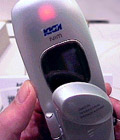Digital Broadcast to Mobile Phones
 KDDI R&D Laboratories have jointly developed a mobile-phone terminal that receives digital terrestrial TV broadcasts with interactive services in conjunction with NHK Science and Technical Research Labs. The two companies are the first in Japan to develop such a product in advance of digital TV broadcasting aimed at mobile terminals, which is due to commence in fiscal 2005. We visited NHK’s open house for a peek at the prototype, a modified Hitachi W11H 3G handset. The demonstration allowed users to watch a newscast and scroll through a menu of relevant links to view different segments, like weather forecasts or sports highlights. Full Program Run-time 4:26, also available in Real Player and QT formats.
KDDI R&D Laboratories have jointly developed a mobile-phone terminal that receives digital terrestrial TV broadcasts with interactive services in conjunction with NHK Science and Technical Research Labs. The two companies are the first in Japan to develop such a product in advance of digital TV broadcasting aimed at mobile terminals, which is due to commence in fiscal 2005. We visited NHK’s open house for a peek at the prototype, a modified Hitachi W11H 3G handset. The demonstration allowed users to watch a newscast and scroll through a menu of relevant links to view different segments, like weather forecasts or sports highlights. Full Program Run-time 4:26, also available in Real Player and QT formats.

